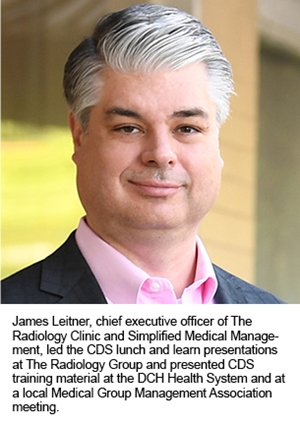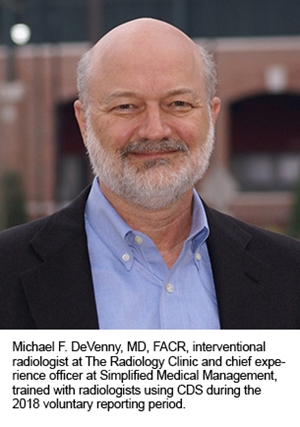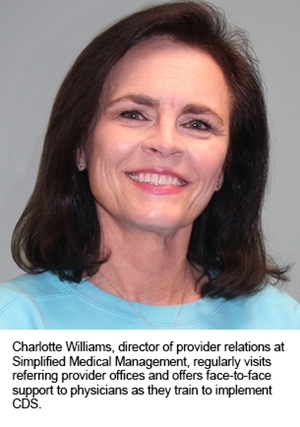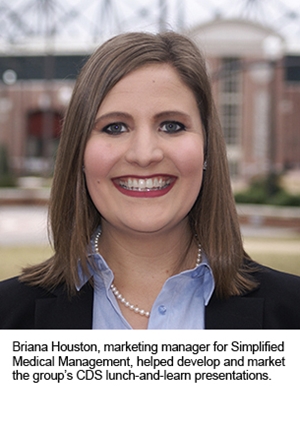Alabama radiologists host two lunch and learns to teach referring physician practices about clinical decision support.
- Radiologists in Tuscaloosa, Alabama, trained on clinical decision support (CDS) so that they could answer referring physicians’ questions related to the Protecting Access to Medicare Act.
- The radiology team developed two lunch and learns to teach referring physicians about CDS. The events included a demonstration of CDS technology using real patient scenarios.
- More than 80 representatives from 49 referring physician practices attended the lunch and learns, and many have begun implementing CDS into their workflow.
 Watch the companion video.
Watch the companion video.The implementation phase of the Protecting Access to Medicare Act (PAMA) , which requires clinicians to consult clinical decision support (CDS) for advanced imaging orders, takes effect this year, but many referring physicians remain unsure about how it will impact them. In fact, when James Leitner, CEO of The Radiology Clinic, a private radiology practice in Tuscaloosa, Alabama, asked referring providers at a recent CDS lunch and learn if they’d heard of the technology, only one of about 45 hands went up.
Under PAMA, referring physicians have all of 2020 to acclimate to consulting appropriate use criteria through CDS when ordering advanced imaging, including MRIs and CT scans. But starting in 2021, radiologists will begin incurring financial penalties for advanced imaging scans that have been performed without proper documentation that the ordering provider has consulted AUC via a qualified CDS mechanism.
Though lowering costs and avoiding financial penalties are important priorities, Leitner, who is also the CEO for Simplified Medical Management, The Radiology Clinic’s non-clinical staff, technology, and resources management organization, says that CDS is invaluable to patient care. “It’s important that patients are not overexposed to radiation, and CDS ensures they get the appropriate test at the appropriate time,” he says.
Recognizing that some referring providers have not yet begun instituting CDS, The Radiology Clinic and Simplified Medical Management held two lunch and learns in late summer of 2019 to familiarize the practices with the technology. After following up with attendees, The Radiology Clinic and Simplified Medical Management have learned that almost every referring physician practice that attended the lunch and learns has since jump-started their CDS implementation.
“Referring offices often get swamped and have little time to learn about and comply with new Medicare requirements,” says Charlotte Williams, director of provider relations at Simplified Medical Management. “They are very grateful for support from radiologists as new policies roll out regarding imaging appropriateness.”
Learning CDS
The Radiology Clinic began planning for CDS during the 2018 voluntary reporting period. The radiologists were trained to use the technology through a CDS vendor that aligns with the most widely used insurance company in Alabama. “Our radiologists wanted to get out in front of this change so that we could be a valuable resource to the hospital and outpatient community when the CDS implementation period occurred,” says Michael F. DeVenny, MD, FACR, interventional radiologist at The Radiology Clinic and chief experience officer at Simplified Medical Management. “We want to be a resource when referring providers call — and they will call,” he continues. “If we can explain CDS to them and walk them through how it works, referring physicians will soon be ordering the right exam for the right patient at the right time, which is exactly what we want. This dedication helps demonstrate that we’re committed to serving as both patient and physician advocates.”
“We want to be a resource when referring providers call — and they will call,” he continues. “If we can explain CDS to them and walk them through how it works, referring physicians will soon be ordering the right exam for the right patient at the right time, which is exactly what we want. This dedication helps demonstrate that we’re committed to serving as both patient and physician advocates.”
But the clinic’s commitment to supporting physicians and patients didn’t stop there. They wanted to do more to make the transition to CDS as smooth as possible. “Implementing CDS is new, and physicians often feel helpless during change,” says DeVenny. “They are trying to offer the best patient care that they can, and they are trying to keep up with these advancements. Helplessness can easily turn into frustration if they don’t have the right resources. That is where we saw a place to add value.”
The Radiology Clinic and Simplified Medical Management already had a robust and successful lunch-and-learn program in place. They often invite referring providers to The Radiology Clinic for training sessions about new requirements, such as prior authorization for advanced imaging or coding changes. “Our referring physician com-munity has been very responsive to coming to our lunch and learns,” says Briana Houston, marketing manager for Simplified Medical Management. “Our goal is to always be a source of information and knowledge that they can lean on, and the lunch and learns were so successful that we followed the same format to share information about CDS.”
Developing a Presentation
Simplified Medical Management led programming development for two CDS lunch and learns in August of 2019. Leitner, Houston, and Williams met to discuss the format and decided that a demonstration of CDS using real patient scenarios would be the most effective way to educate providers about the challenges and opportunities of the technology. “Using real patient scenarios helps give providers an idea of what information they will be prompted to provide and what their options will be using CDS,” Williams says.Along with developing a hands-on demonstration, the team spent about 30 hours over several weeks creating a presentation for the lunch and learns. The group used its CDS vendor’s list of frequently asked questions and the Centers for Medicare & Medicaid Services (CMS) resources for CDS to build the presentation , which included information about the history of PAMA, the overall impact to and role of referring physician offices in implementing CDS, guidance on important CDS clinical language, and additional details about CDS.
The ultimate goal, Houston says, was to encourage practices to begin implementing CDS before the financial penalties take effect. “We thought that if ordering providers attended this training, they could start familiarizing themselves with the technology, and we’d provide support along the way,” she says. “We want to empower them to slowly roll out CDS so that we can work out any issues now and help them to troubleshoot these areas before CDS is mandatory.”
Spreading the Word
Simplified Medical Management began marketing the lunch and learns to physician offices about two months before the first event. The group distributed paper and digital invitations to all of its referring offices, and staff members called and visited clinical offices in the area to let them know about the program. The group also advertised the lunch and learns, including a brief overview about what to expect from CDS, in the monthly newsletter it distributes to all of its referring physicians. To extend their outreach and promote continuity across the healthcare community, the group partnered with DCH Health System, the hospital system that The Radiology Clinic serves, to advertise and fund the CDS lunch-and-learn program. “If you are in lock step with your hospital system and everyone is hearing the same message, then there is little room for confusion,” DeVenny says. “Working together allows the community to receive the best care.”
To extend their outreach and promote continuity across the healthcare community, the group partnered with DCH Health System, the hospital system that The Radiology Clinic serves, to advertise and fund the CDS lunch-and-learn program. “If you are in lock step with your hospital system and everyone is hearing the same message, then there is little room for confusion,” DeVenny says. “Working together allows the community to receive the best care.”
Leon H. Campbell Jr., MD, an internist at Care Plus who specializes in internal medicine and pain management, first heard about the lunch and learns from Williams. He was eager to participate in one of the events and take what he learned back to his practice, which often orders advanced imaging and will be affected by the legislation. “I could tell I needed to go to one of the lunch and learns because implementing CDS sounded intimidating and terrible,” he says with a laugh. “I wanted to learn what I could to make the implementation go as smoothly as possi-ble.”
Gathering Results
The lunch and learns were held at The Radiology Clinic on two days in August of 2019. Simplified Medical Management and the DCH Health System provided lunch at 11:30 a.m., and the presentation began around noon and lasted about 40 minutes with time for questions.Campbell appreciated the opportunity to learn directly from the radiology group because he regards them as the experts in imaging policy and procedures, and he now feels much more prepared to implement the technology into his own practice. “If I had to learn CDS on my own,” he says, “I’d probably get really uptight and intimidated. I really appreciate the radiologists taking the lead because they are more knowledgeable about using CDS to consult evidence-based guidelines for appropriate imaging than I am.”
More than 80 clinical and non-clinical staff representing 49 offices attended the two lunch and learns, and feedback has been overwhelmingly positive. “Physicians began calling almost immediately after the events to see if they could get a copy of the presentation material,” Houston says. “Many practices called other offices they didn’t see at the lunch and learns and told them they needed to reach out to us.”
Williams, who regularly visits referring provider offices, has followed up with referring physicians and has found that most of the practices have begun to consult CDS when ordering advanced imaging. “Sitting down with providers to explain CDS and answer their questions has improved their confidence,” says Williams. “As a result, many offices began to implement CDS soon after our presentations.”
Continuing Efforts
After the lunch and learns, The Radiology Clinic also followed up with local providers through its September newsletter. The newsletter provided links to the lunch- and-learn presentation for those who missed the event, along with links to CDS resources. Many practices continue to reach out to The Radiology Clinic and Simplified Medical Management as a resource as they begin to implement CDS. To further support those who were unable to attend, Williams has delivered presentations at 48 local referring physician practices, and Leitner delivered the CDS presentation during DCH Health System’s semi-annual symposium and at a local Medical Group Management Association meeting in November. The team plans to present information about CDS at future staff meetings and to continue providing this training throughout the 2020 implementation year to providers in the community who will need to use CDS.
To further support those who were unable to attend, Williams has delivered presentations at 48 local referring physician practices, and Leitner delivered the CDS presentation during DCH Health System’s semi-annual symposium and at a local Medical Group Management Association meeting in November. The team plans to present information about CDS at future staff meetings and to continue providing this training throughout the 2020 implementation year to providers in the community who will need to use CDS.
“Referring physicians don’t have additional time to spend researching all of these changes,” says Williams. “They often don’t know how these changes will affect them until we go out there and explain it during a presentation or hands-on training. Those who have already heard the presentation also say they benefit from hearing the presentation a second time; hearing the presentation a second time expands the base knowledge they gained from the first.”
Changing for the Better
While CDS implementation represents a big change within healthcare, DeVenny argues that the benefits outweigh the challenges. He sees programs, such as lunch and learns, as a way to help lessen the strain of this kind of change. “Anytime someone comes in and tries to layer something on top of what you are already doing, it is at first frustrating,” he says. “But CDS encourages decreased and appropriate utilization so that the patient gets the right exam for the right reason. When you think about it that way, it becomes easier to embrace. It’s more work initially, but it’s well worth the investment.”Although time is often a concern for busy radiologists, Houston suggests that there is no need to reinvent the wheel when considering ways to educate the local medical community about CDS. “Investigate resources that are out there through ACR and start providing those resources,” she says. “Train your staff on those resources and have your liaisons take this knowledge to offices or offer the information digitally through newsletters.”
DeVenny argues that radiologists are essential to ensuring CDS is implemented smoothly. “Too much of what we have done in the past is just trying to keep up and increase efficiency,” he says. “Hosting programs like lunch and learns is a way for us to reintegrate into patient care and be seen as just what we are: the experts in imaging.”
Creative Commons
Training for CDS Implementation by American College of Radiology is licensed under a Creative Commons Attribution-NonCommercial-NoDerivatives 4.0 International License. Based on a work at www.acr.org/imaging3. Permissions beyond the scope of this license may be available at www.acr.org/Legal.Share Your Story
Have a case study idea you’d like to share with the radiology community? To submit your idea, please click here.Next Steps
- Share ACR CDS resources with referring physicians through provider liaisons, emails, newsletters, pamphlets, and other media.
- Ensure that you are familiar with the CDS mechanisms most used in your area and develop opportunities to present live demonstrations of these tools.
- Follow up with providers after distributing information to answer questions and to create open communication about CDS.
Author
Chelsea Krieg is a freelance writer.
Join the Discussion

Want to join the discussion about how radiologists
can lead quality improvement projects for improved
image ordering? Let us know your thoughts on
Twitter at #imaging3.
#Imaging3 on Twitter
Call for Case Studies
